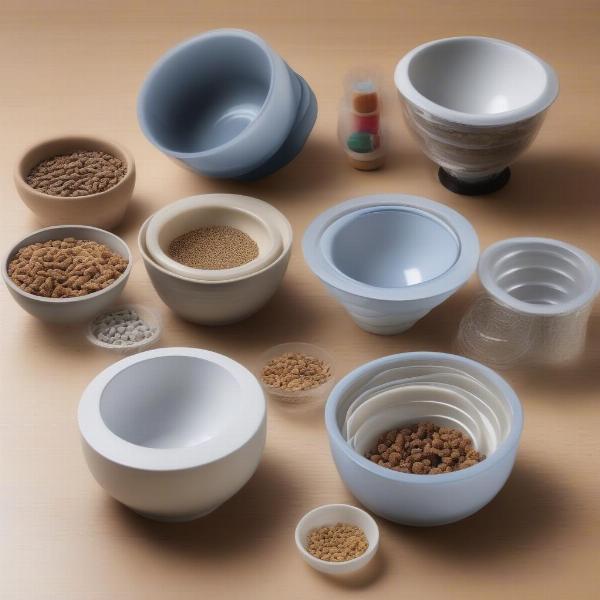Slow feeder dog bowls are designed to do exactly what their name suggests: slow down your dog’s eating. But why is this important? For many dogs, gobbling down their food in seconds can lead to a variety of health issues, from choking and vomiting to bloating and even a life-threatening condition called Gastric Dilatation-Volvulus (GDV). A slow feeder bowl can be a simple yet effective solution to these problems. Choosing the right bowl depends on your dog’s breed, size, and eating habits, and this guide will cover everything you need to know about selecting and using a slow feeder bowl for your furry friend.
Why Use a Slow Feeder Dog Bowl?
Rapid eating isn’t just messy; it can be detrimental to your dog’s health. When dogs eat too quickly, they swallow large amounts of air along with their food. This can cause bloating, discomfort, and excessive gas. More seriously, it can lead to vomiting and regurgitation, or even the dangerous condition known as GDV, particularly in large, deep-chested breeds. Slow feeder bowls present a physical challenge, forcing your dog to work for their food, thus reducing the speed of ingestion and the amount of air swallowed. This promotes better digestion, reduces the risk of health issues, and can even turn mealtime into a more engaging and enriching experience.
Choosing the Right Slow Feeder Bowl
The market offers a plethora of slow feeder bowls, varying in design, material, and size. Selecting the right one for your dog requires considering several factors.
Material Matters
- Stainless Steel: Durable, easy to clean, and dishwasher-safe. stainless steel slow feeder dog bowl
- Plastic: Generally less expensive but can be chewed or scratched by determined dogs.
- Ceramic: Often more aesthetically pleasing but can be prone to chipping or breaking.
Design Considerations
Slow feeder bowls use various designs to slow down eating. Some common designs include:
- Raised Obstacles: These create a maze-like structure that forces dogs to maneuver around them to get to the food.
- Ridges and Valleys: Similar to raised obstacles, these create a more challenging eating surface.
- Spiral Designs: Food is dispersed along a spiral track, requiring dogs to work their way around to access all of it.
 Different Types of Slow Feeder Bowls
Different Types of Slow Feeder Bowls
Size and Breed
Choose a bowl size appropriate for your dog’s breed and size. A small bowl for a large dog will be ineffective, while a large bowl for a small dog might be overwhelming. large dog slow feeder bowl Consider your dog’s eating habits as well. If your dog is particularly persistent, a more challenging design might be necessary.
Introducing Your Dog to a Slow Feeder Bowl
Switching to a slow feeder bowl should be a gradual process. Start by offering a small amount of food in the new bowl alongside their regular bowl. This allows your dog to get used to the new design without feeling frustrated. Gradually increase the amount of food in the slow feeder while decreasing the amount in the regular bowl. Be patient and encouraging, and your dog will soon adapt to the new eating style.
Are There Any Downsides to Slow Feeder Bowls?
While slow feeder bowls offer significant benefits, there are a few potential downsides to consider:
- Frustration: Some dogs, especially those with anxiety or food aggression, might become frustrated with the challenge.
- Cleaning: Bowls with intricate designs can be more challenging to clean thoroughly. stainless steel dog bowl slow feeder
- Durability: Plastic bowls can be chewed or damaged by determined dogs.
Conclusion
Slow feeder bowls are a valuable tool for promoting healthy eating habits in dogs. By slowing down their eating pace, these bowls can significantly reduce the risk of digestive issues and improve overall well-being. slow feeder dog bowl for dogs Choosing the right bowl involves considering the material, design, and your dog’s individual needs. With patience and the right approach, a slow feeder bowl can transform mealtime into a safer and more enjoyable experience for your furry companion.
FAQ
- Do all dogs need a slow feeder bowl? While not strictly necessary for every dog, slow feeder bowls are particularly beneficial for fast eaters and breeds prone to bloating.
- Can puppies use slow feeder bowls? Yes, introducing a slow feeder from a young age can establish good eating habits.
- How do I clean a slow feeder bowl? Most slow feeders are dishwasher-safe, but hand washing with soap and water is also effective.
- What if my dog gets frustrated with the slow feeder? Try starting with a less challenging design and gradually introduce more complex ones.
- Are slow feeders effective for all types of dog food? Yes, they work with both dry and wet food, though some designs may be better suited for one or the other.
- How can I tell if my dog is eating too fast? Signs of fast eating include choking, gagging, vomiting, and gulping large amounts of food in seconds.
- Can slow feeders help with weight management? While not a primary weight-loss tool, slowing down eating can help dogs feel fuller and more satisfied, potentially aiding in portion control.
ILM Dog is your global resource for expert dog care and advice. We offer comprehensive information on all aspects of dog ownership, from breed selection and health care to training, nutrition, and product recommendations. Our expert team is dedicated to providing practical, reliable advice to help you provide the best possible care for your canine companion. Whether you’re a new dog owner or a seasoned expert, ILM Dog is here to support you every step of the way. For expert advice tailored to your dog’s individual needs, contact us at [email protected] or call us at +44 20-3965-8624. Visit ILM Dog for more valuable information and resources!